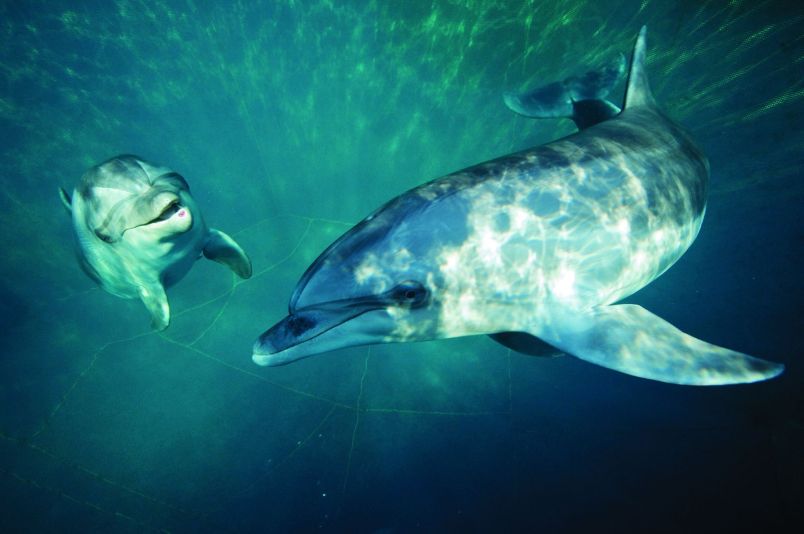SAN DIEGO (AP) — The U.S. Navy plans to increase sonar testing over the next five years, even as research it funded reveals worrying signs that the loud underwater noise could disturb whales and dolphins.
Reported mass strandings of certain whale species have increased worldwide since the military started using sonar half a century ago. Scientists think the sounds scare animals into shallow waters where they can become disoriented and wash ashore, but technology capable of close monitoring has emerged only in about the last decade.
Aside from strandings, biologists are concerned marine mammals could suffer prolonged stress from changes in diving, feeding and communication.
Two recent studies off the Southern California coast found certain endangered blue whales and beaked whales stopped feeding and fled from recordings of sounds similar to military sonar.
Beaked whales are highly sensitive to sound and account for the majority of beachings near military exercises. Scientists, however, were surprised by the reaction of blue whales — the world’s largest animal — long thought to be immune to the high-pitched sounds. It’s unclear how the change in behavior would affect the overall population, estimated at between 5,000 and 12,000 animals.
The studies involved only a small group of tagged whales and noise levels were less intense than what’s used by the Navy. Shy species, such as the Cuvier’s beaked whale that can dive 3,000 feet below the surface, have taken years to find and monitor.
“This is a warning flag and deserves more research,” said Stanford University biologist Jeremy Goldbogen, who led the blue whale study published this summer in the journal Proceedings of the Royal Society B.
Both studies were done by a team of independent scientists as part of a Navy-funded, five-year project launched in 2010 to understand how sonar affects marine mammals.
Navy officials say it’s vital to national security that sailors receive sonar training in real-life conditions.
Environmentalists have long claimed that sonar harms marine mammals, which use acoustics to mate and forage. They want more protections and accuse the Navy of rushing to obtain five-year permits under the Marine Mammal Protection Act from the National Marine Fisheries Service to increase its sonar testing in U.S. waters without considering the latest science.
“If you deafen a marine mammal for even a short period time, you are affecting its ability to survive,” said Michael Jasny of the Natural Resources Defense Council, whose group has sued to force the Navy to add more protections.
A federal judge in September ruled marine fisheries officials did not consider the best available data when it approved permits last year for operations stretching from Northern California to the Canadian border. The agency has until August to reassess how it will protect ocean life.
The California Coastal Commission also rejected the Navy’s five-year plan for exercises that would start in January off Southern California. However, the state agency does not have the power to block the drills and the Navy has ignored the agency’s requested protections in the past.
The Navy estimates that its activities could inadvertently kill 186 whales and dolphins off the East Coast and 155 off Hawaii and Southern California, mostly from explosives.
It calculates more than 11,000 serious injuries off the East Coast and 2,000 off Hawaii and Southern California, along with nearly 2 million minor injuries, such as temporary hearing loss, off each coast. It also predicts marine mammals might change their behavior — such as swimming in a different direction — in 27 million instances.
Navy officials said they considered the latest research available, including the two recent studies, but none proves the activities cause significant harm to the marine populations.
Navy spokesman Kenneth Hess emphasized that the studies published this summer involved a small group of animals and some did not react, indicating the sound’s distance and other context may play a role. The Navy uses simulators where possible.
“Overall, the activities we propose are very similar to the training and testing we have done in these areas for the past 60 years, and we have not seen major impacts on marine mammals from these activities,” Hess said.
Until now, studies have measured animals’ response based on recordings similar to military sonar or depended on the tagging of marine mammals during Navy at-sea training in which scientists could not control the distance or intensity. For the first time, researchers coordinating with the Navy are conducting experiments using mid-frequency active sonar transmissions from ships. This past summer, they tagged six whales and dolphins off the Southern California coast. Those results are still being analyzed.
Marine fisheries officials last month granted the Navy its permit for activities in the Atlantic and Gulf of Mexico, on the condition that the military review the latest science yearly. The Navy must cease exercises if mammals are spotted nearby, and establish a response plan to a mass stranding. A decision on the Pacific permit is expected to be announced this month.
Some scientists want the Navy to create safety zones that would guarantee no high-intensity sonar activity near marine sanctuaries and areas with a high concentration of blue, fin and gray whales seasonally.
“There are the ocean equivalent of deserts where sonar exercises could be conducted which would be vastly safer,” said Lindy Weilgart, a biologist at Dalhousie University in Canada who doesn’t receive any Navy funding.
Copyright 2013 The Associated Press. All rights reserved. This material may not be published, broadcast, rewritten or redistributed.






